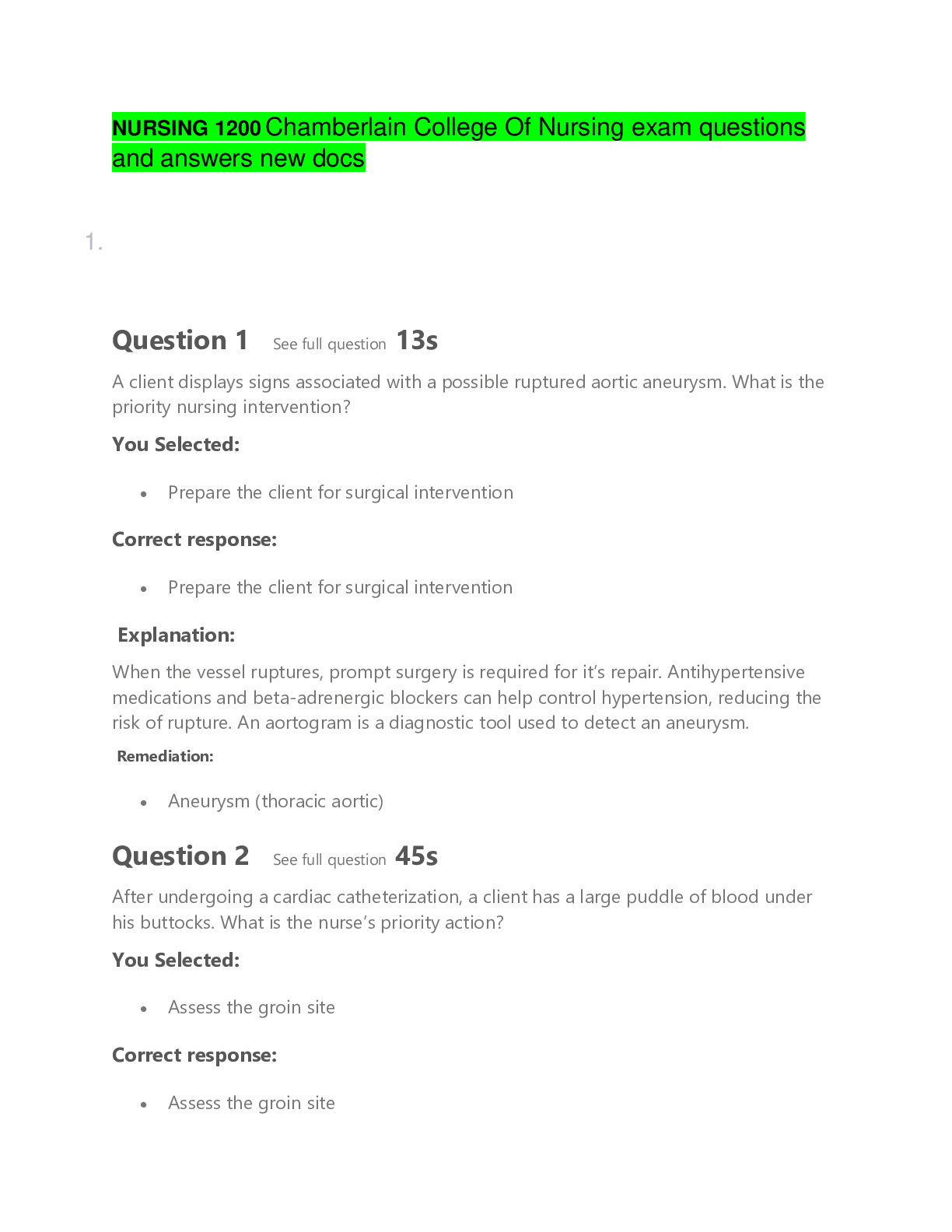Religious Studies > QUESTIONS & ANSWERS > theo 206 Question Bank Quiz 3 exam questions and answers new docs liberty university (All)
theo 206 Question Bank Quiz 3 exam questions and answers new docs liberty university
Document Content and Description Below
theo 206 Question Bank Quiz 3 exam questions and answers new docs liberty university Question 1: What is Docetism? a. The Belief that Christ only seemed to be divine b. The Belief that Chr... ist was human c. The Belief that Christ only seemed to have a human body d. The belief that Christ was divine. Question 2: The Donatists were a group of African Clergy who: a. Embraced ritual purity and separated themselves from the world b. Were followers of bishop Augustine of Hippo c. Protested against the divinity of Jesus d. Invented and sold donuts in early Christianity. Question 3: Manichaeism Argued that: a. Jesus was a disciple of Mani b. The soul will not exist once the person dies c. The virgin mary was not the mother of jesus d. Evil is due to a permanent cosmic conflict between Light and dark. Question 4: The Creed of Nicaea (of 325 CE) stated that: a. Jesus is consubstantial with the father b. the Holy Spirit does not exist c. God is not the father of Jesus d. Not god but Satan created the world. Question 5: Why was Diocletian Relevant to Christianity? a. It was the city where the first defense of Jesus’ divinity took place b. He persecuted Christians c. He called the council of Nicaea d. He defeated emperor Constantine in the battle at the Milvian Bridge in Rome. Question 6: The Montanists were a third century Christian Group that favoured: a. A church of the spirit and prophecy over one of bishops b. Living in the purity of mountain air c. Declaring Mary Magdalene a bishop d. Opposing the Gnostics to the biter end. Question 7: The Marcionites believed that: a. Paul and Jesus were one and the same person b. The Old Testament is the real scripture they should use c. The only real scriptures are the Gospel of Luke, and Paul’s epistles. d. Marcion was a Jewish prophet. Question 8: Which one of the following dates marks the definitive division of the Christian empire into east and west? a. 70 AD b. 395 AD c. 3 BC d. 325 AD Question 9: Which one of the following councils condemned Arius and added to the creed the word “homoousios” (of one substance)? a. The Council of Nicaea b. The Council of Constantinople c. The Council of Chalcedon d. The Council of Ephesus. Question 10: Which one of the following characters saw in free will a divine gift ( a “natural grace”) allowing one to act freely towards one’s salvation? a. Pelagius b. Arius c. Montanus d. Constantine Question 11: Athanasius of Alexandria was one of the main players in which controversy? a. The Nestorian Controversy b. The Pelagian Controversy c. The Arian Controversy d. None of these choices Question 12: Which one of the following councils established God as being one in nature (or substance) and three in persons (Father, Son, and Holy Spirit)? a. The council of Constantinople b. The Council of Ephesus c. The council of Nicaea d. The council of Athens Question 13: The Edict of Milan Did what for Christianity? a. Allowed Diocletian to persecute Christians b. Established tolerance towards Christianity c. Allowed pagan to use Christians as scapegoats d. Converted Constantine to Christianity. Question 14: Which book did Marcion believe dealt with an inferior God? a. The Hebrew bible b. The gospels c. The book of revelation d. Paul’s letters Question 15: Diocletian was: a. A fourth century roman emperor b. A second century theologian c. None of these choices d. The name of a Roman City Question 16: Which one of the following groups believed that Jesus was a creature and had not always existed? a. The Marcionites b. The Montanists c. The Arians d. The Donatists Question 17: Arius was the fourth century Egyptian priest who: a. Died as a result of being bitten by a crocodile on the Nile river b. Affirmed that Jesus is a mere creature c. Baptized emperor Constantine on his deathbed d. Protested against emperor Constantine. Question 18: Why is the battle of the Milvian Bridge relevant to Christianity? a. Diocletian murdered all the bishops in Rome b. Constantine had his vision of the Cross c. This battle united the empire east and west d. This battle defeated the pagans. Question 19: Which one of the following cult gods began the move towards monotheism? a. Zeus b. Minerva c. Athena d. Sun God Question 20: The Patriarch Nestorius of Constantinople (428-431) argued that: a. Empress Pulcheria should not be baptized as a Christian b. The Virgin Mary should not be called “Mother of God” c. Emperor Constantine was no Christian d. Cyril of Alexandria denied the divinity of Jesus. Question 21: Orthodoxy Refers to: a. The doctrine the early church crystalized by means of exclusions of other groups. b. Buddhism. c. Donatus’ doctrine about the church belonging only to the saints d. The doctrine of the Gnostics. Question 22: The Doctrine about the person and works of Jesus Christ is referred to as: a. Christology b. Christianity c. Trinitarianism d. Monotheism Question 23: Which one of the following are near eastern divinities mentioned in the Hebrew bible? a. Tiamath b. Baal c. All of these choices d. Marduk. Question 24: Which one of the following Characters stated that the logos took the place of the human soul in Jesus Christ, therefore Jesus’ human nature would be incomplete? a. Origen b. Gregory of Nazianzus c. Clement d. Apollinarius of Laodicaea Question 25: According to the Christological definition of Chalcedon, Mary is: a. A virgin who never gave birth b. The virgin god Bearer (or Mother of God) c. The cousin of Jesus d. Elizabeth’s Cousin Question 26: The Theologians from which city tended to interpret the bible literally and historically, which lead to a low Christology? a. Antioch b. Alexandria c. Corinthian d. Ephesus Question 27: According to the Christological definition of Chalcedon, Jesus: a. Is two persons, one divine and one human. b. Is one person, in two natures, divine and human. c. Is only God d. Neither really God, Nor really Human. Question 28: The council of Ephesus in 431 came up with the ingredients of a doctrine of “hypostatic union” in regards to Jesus Christ, which means that: a. A true personal union of two natures took place b. Jesus was not of the same substance as the Father c. There was no personal union of two natures (human and divine) of Jesus d. Jesus’ divine and human natures were only loosely united. Question 29: Under the influence of Jewish monotheism, some Christians affirmed God’s oneness; Son and Spirit were mere: a. Aspects, Masks b. Dupicates c. Illusions d. Fictional chracters Question 30: Which one of the following had a great impact on the rise of monotheism emphasizing that the many gods were in fact aspects of a single god? a. Philosophers and Philosophy third century b. Jesus c. Athanasius d. Paul Question 31: According to the Council of Ephesus 431 CE: a. Christ was God in human disguise b. Christ was both god and human united in one person c. Christ was just a creature like us humans d. Question 32: In his confessions 7, Augustine finally comes to the understanding of: a. Celibacy b. Life c. God, Christ and evil d. The bible Question 33: Original Sin refers to the: a. Ability to create sin that has a high degree of originality b. Jesus’ suffering and death on the cross c. Sin of Adam and Eve that was somehow transmitted to the entire human race d. the fact that jesus was offering to forgive sins Question 34: Which of the following is a literary style of patristic literature? a. Apologetic b. All of these choices c. Complimentary d. Polemic Question 35: Who coined the phrase Original sin? a. Jesus Christ b. Basil of Caesarea c. Emperor Constantine d. Augustine of Hippo Question 36: According to Augustine, Sexuality: a. Passes easily out of rational control b. Is to be condemned c. Was meant to be enjoyed for its own sake d. Is a regrettable mistake. Question 37: The Christian Augustine maintained that: a. Mani was right that matter is evil b. Sexuality is to be condemned c. Christianity was nothing but Platonism for the masses d. The world is good because a good god created it. Question 38: In 553 a counsel of bishops convened by emperor condemned which theologian as a heretic: a. Athanasius b. Philo of Alexandria c. Augustine d. Origen Question 39: The Story of “The Slave Child and the Rich Child”, which lead to the realization that astrology was false is found in the book of which theologian? a. Athanasius of Alexandria b. Origen c. Justin Martyr d. Augustine Question 40: Augustine put the book of revelation in a totally new perspective by arguing that: a. No empire can be evil per se, but church and state should collaborate. b. The four beasts revelation referred to four Christian emperors c. the number 666 referred to emperor Diocletian d. the end of the world will come during his life time. Question 41: Which of Origen’s ideas were condemned by the Church? a. The Spherical shape of the resurrected body b. All of these choices c. The preexistence of the soul d. The universal salvation of all rational beings. Question 42: According to Augustine, God created the “seminal principles”: a. As the basis for everything that subsequently came to be b. To affirm that Jesus is his son. c. In order to deal with Jesus d. To escape the sadness he was experiencing because his son Jesus was crucified. Question 43: Which one of the following characters was intrepid defender of Nicaea against the Arians? a. Origen b. Constantine c. Athanasius d. Cyril of Alexandria Question 44: Augustine of Hippo was a catholic theologian who: a. Was in pursuit of bodily pleasures after becoming a bishop b. Argued in favor of the crusades c. Influenced many fields of life, including theology, political science and psychology. d. Maintained, with Mani, that the material world Is evil. Origins of Christianity (THEO 206) Quiz 3: Submission Review Legend: Your correct response is highlighted in green. Your incorrect response is highlighted in red. If you did not select the correct answer, it will be highlighted in blue. THE PAINFUL PARTITION (150-430) LESSON 7 Question 1: (1 Points) The Donatists were a group of African clergy who: a. were followers of bishop Augustine of Hippo b. protested against the divinity of Jesus c. embraced ritual purity and separated themselves from the world d. invented and sold donuts in early Christianity Question 2: (1 Points) The Montanists were a third-century Christian group that favored: a. declaring Mary Magdalene a bishop b. opposing the Gnostics to the bitter end c. living in the purity of mountain air d. a church of the Spirit and prophecy over one of bishops Question 3: (1 Points) The Marcionites believed that: a. the Old Testament is the real scripture they should use b. The only real scriptures are the Gospel of Luke, and Paul’s epistles c. Marcion was a Jewish prophet d. Paul and Jesus were one and the same person Question 4: (1 Points) Why was Diocletian relevant to Christianity? a. he persecuted Christians b. he called the Council of Nicaea c. he defeated emperor Constantine in the Battle at the Milvian Bridge in Rome d. it was the city where the first defense of Jesus' divinity took place Question 5: (1 Points) The Edict of Milan did what for Christianity? a. Established tolerance towards Christianity b. Allowed Diocletian to persecute Christians c. Converted Constantine to Christianity d. Allowed pagan to use Christians as scapegoats Question 6: (1 Points) Which one of the following councils established God as being one in nature (or substance) and three in persons (Father, Son, and Holy Spirit)? a. The council of Ephesus b. The council of Constantinople c. The council of Athens d. The council of Nicaea Question 7: (1 Points) What is Docetism? a. The belief that Christ was divine b. The belief that Christ only seemed to be divine c. The belief that Christ only seemed to have a human body d. The belief that Christ was human Question 8: (1 Points) Manichaeism argued that: a. evil is due to a permanent cosmic conflict between Light and Dark b. Jesus was a disciple of Mani c. the Virgin Mary was not the mother of Jesus d. the soul will not exist once the person dies Question 9: (1 Points) Which one of the following dates marks the definitive division of the Christian empire into east and west? a. 70 AD b. 395 AD c. 325 AD d. 3 BC Question 10: (1 Points) Which one of the following characters saw in free will a divine gift (a “natural grace”) allowing one to act freely towards one's salvation? a. Montanus b. Pelagius c. Constantine d. Arius Question 11: (1 Points) Which one of the following groups believed that Jesus was a creature and had not always existed? a. The Montanists b. The Marcionites c. The Arians d. The Donatists Question 12: (1 Points) The Creed of Nicaea (of 325 CE) stated that: a. not God but Satan created the world b. the Holy Spirit does not exist c. God is not the Father of Jesus d. Jesus is consubstantial with the Father Question 13: (1 Points) Diocletian was: a. a second-century theologian b. a fourth-century Roman emperor c. None of these choices d. the name of a Roman city Question 14: (1 Points) Which book did Marcion believe dealt with an inferior God? a. The Hebrew Bible b. The Book of Revelation c. Paul's letters d. The Gospels Question 15: (1 Points) Athanasius of Alexandria was one of the main players in which controversy? a. The Nestorian controversy b. The Arian controversy c. None of these choices d. The Pelagian controversy Question 16: (1 Points) Which one of the following councils condemned Arius and added to the Creed the word “homoousios” (of one substance)? a. The Council of Chalcedon b. The Council of Nicaea c. The Council of Ephesus d. The Council of Constantinople Question 17: (1 Points) Why is the Battle of the Milvian Bridge relevant to Christianity? a. This battle united the empire east and west b. This battle defeated the pagans c. Constantine had his vision of the cross d. Diocletian murdered all the bishops in Rome Question 18: (1 Points) Arius was the fourth-century Egyptian priest who: a. baptized emperor Constantine on his deathbed b. protested against emperor Constantine c. affirmed that Jesus is a mere creature d. died as a result of being bitten by a crocodile on the Nile River GODS, GOD, AND CHRIST (381-681) LESSON 8 Question 1: (1 Points) Under the influence of Jewish monotheism, some Christians affirmed God’s oneness; Son and Spirit were mere: a. Aspects, masks b. Duplicates c. Fictional characters d. Illusions Question 2: (1 Points) The council of Ephesus in 431 came up with the ingredients of a doctrine of “hypostatic union” in regards to Jesus Christ, which means that: a. There was no personal union of two natures (human and divine) of Jesus b. Jesus was not of the same substance as the Father c. A true personal union of two natures took place in Jesus d. Jesus’ divine and human natures were only loosely united Question 3: (1 Points) The doctrine about the person and works of Jesus Christ is referred to as: a. Christology b. Christianity c. Monotheism d. Trinitarianism Question 4: (1 Points) According to the Christological definition of Chalcedon, Jesus: a. is two persons, one divine and one human b. neither really god, nor really human c. is only God d. is one person, in two natures, divine and human Question 5: (1 Points) Which one of the following characters stated that the Logos took the place of the human soul in Jesus Christ, therefore Jesus’ human nature would be incomplete? a. Origen b. Apollinarius of Laodicaea c. Clement d. Gregory of Nazianzus Question 6: (1 Points) Which of the following are near eastern divinities mentioned in the Hebrew Bible? a. Marduk b. All of these choices c. Tiamath d. Baal Question 7: (1 Points) Which of the following cult gods began the move towards monotheism? a. Sun God b. Zeus c. Athena d. Minerva Question 8: (1 Points) According to the Christological definition of Chalcedon, Mary is: a. a virgin who never gave birth b. the cousin of Jesus c. Elizabeth’s cousin d. the virgin God-bearer (or Mother of God) Question 9: (1 Points) Which one of the following had a great impact on the rise of monotheism emphasizing that the many gods were in fact aspects of a single god? a. Jesus b. Paul c. Athanasius d. Philosophers and philosophy third century Question 10: (1 Points) The Theologians from which city tended to interpret the Bible literally and historically, which lead to a low Christology? a. Antioch b. Corinthian c. Ephesus d. Alexandria Question 11: (1 Points) According to the Council of Ephesus of 431 CE: a. Christ was both God and human united in one person b. Christ was God in human disguise c. Christ was a just a creature like us humans Question 12: (1 Points) Orthodoxy refers to: a. Donatus’ doctrine about the church belonging only to the saints b. Buddhism c. the doctrine of the Gnostics d. the doctrine the early church crystallized by means of exclusions of other groups Question 13: (1 Points) The patriarch Nestorius of Constantinople (428-431) argued that: a. Emperor Constantine was no Christian b. The Virgin Mary should not be called "Mother of God" c. Cyril of Alexandria denied the divinity of Jesus d. Empress Pulcheria should not be baptized as a Christian HEYDAY OF PATRISTIC LITERATURE LESSON 9 Question 1: (1 Points) The story of “The Slave Child and the Rich Child”, which lead to the realization that astrology was false is found in the book of which theologian? a. Justine Martyr b. Athanasius of Alexandria c. Augustine d. Origen Question 2: (1 Points) In his Confessions 7, Augustine finally comes to the understanding of: a. God, Christ and evil b. Celibacy c. The bible d. Life Question 3: (1 Points) Augustine of Hippo was a Catholic theologian who: a. maintained, with Mani, that the material world is evil b. argued in favor of the crusades c. was in pursuit of bodily pleasures after becoming a bishop d. influenced many fields of life, including theology, political science, and psychology Question 4: (1 Points) Which of the following is a literary style of patristic literature? a. Polemic b. All of these choices c. Commentary d. Apologetic Question 5: (1 Points) According to Augustine, sexuality: a. is a regrettable mistake b. is to be condemned c. was meant to be enjoyed for its own sake d. passes easily out of rational control Question 6: (1 Points) Who coined the phrase "original sin"? a. Augustine of Hippo b. Basil of Caesarea c. Emperor Constantine d. Jesus Christ Question 7: (1 Points) Which one of the following characters was intrepid defender of Nicaea against the Arians? a. Athanasius b. Cyril of Alexandria c. Constantine d. Origen Question 8: (1 Points) "Original sin" refers to the: a. ability to create sin that has a high degree of originality b. the fact that Jesus was offering to forgive sins c. Jesus’ suffering and death on the cross d. sin of Adam and Eve that was somehow transmitted to the entire human race Question 9: (1 Points) According to Augustine, God created the "seminal principles": a. in order to deal with Jesus b. to escape the sadness he was experiencing because his son Jesus was crucified c. to affirm that Jesus is his Son d. as the basis for everything that subsequently came to be Question 10: (1 Points) Augustine put the Book of Revelation in a totally new perspective by arguing that: a. the four beasts of Revelation referred to four Christian emperors b. the number 666 referred to emperor Diocletian c. no empire can be evil per se, but church and state should collaborate d. the end of the world will come during his life time Question 11: (1 Points) The Christian Augustine maintained that: a. Sexuality is to be condemned b. Mani was right that matter is evil c. Christianity was nothing but Platonism for the masses d. The world is good because a good God created it Question 12: (1 Points) Which of Origen’s ideas were condemned by the church? a. All of these choices b. The preexistence of the soul c. The spherical shape of the resurrected body d. The universal salvation of all rational beings Question 13: (1 Points) In 553 a counsel of bishops convened by emperor condemned which theologian as a heretic? a. Athanasius b. Origen c. Augustine d. Philo of Alexandria © 2009 eConcordia.com Inc. All rights reserved. THE PAINFUL PARTITION (150-430) LESSON 7 Question 1: (1 Points) The Montanists were a third-century Christian group that favored: a. opposing the Gnostics to the bitter end b. a church of the Spirit and prophecy over one of bishops c. living in the purity of mountain air d. declaring Mary Magdalene a bishop Question 2: (1 Points) Which one of the following characters saw in free will a divine gift (a “natural grace”) allowing one to act freely towards one's salvation? a. Arius b. Constantine c. Pelagius d. Montanus Question 3: (1 Points) Athanasius of Alexandria was one of the main players in which controversy? a. The Pelagian controversy b. None of these choices c. The Nestorian controversy d. The Arian controversy Question 4: (1 Points) Which one of the following councils established God as being one in nature (or substance) and three in persons (Father, Son, and Holy Spirit)? a. The council of Ephesus b. The council of Athens c. The council of Constantinople d. The council of Nicaea Question 5: (1 Points) Which one of the following dates marks the definitive division of the Christian empire into east and west? a. 395 AD b. 325 AD c. 3 BC d. 70 AD Question 6: (1 Points) The Edict of Milan did what for Christianity? a. Allowed Diocletian to persecute Christians b. Established tolerance towards Christianity c. Converted Constantine to Christianity d. Allowed pagan to use Christians as scapegoats Question 7: (1 Points) Which one of the following councils condemned Arius and added to the Creed the word “homoousios” (of one substance)? a. The Council of Chalcedon b. The Council of Constantinople c. The Council of Ephesus d. The Council of Nicaea Question 8: (1 Points) Which book did Marcion believe dealt with an inferior God? a. The Hebrew Bible b. The Gospels c. Paul's letters d. The Book of Revelation Question 9: (1 Points) Why is the Battle of the Milvian Bridge relevant to Christianity? a. Diocletian murdered all the bishops in Rome b. This battle defeated the pagans c. This battle united the empire east and west d. Constantine had his vision of the cross Question 10: (1 Points) What is Docetism? a. The belief that Christ was divine b. The belief that Christ was human c. The belief that Christ only seemed to be divine d. The belief that Christ only seemed to have a human body Question 11: (1 Points) Why was Diocletian relevant to Christianity? a. it was the city where the first defense of Jesus' divinity took place b. he called the Council of Nicaea c. he persecuted Christians d. he defeated emperor Constantine in the Battle at the Milvian Bridge in Rome Question 12: (1 Points) Manichaeism argued that: a. evil is due to a permanent cosmic conflict between Light and Dark b. the soul will not exist once the person dies c. Jesus was a disciple of Mani d. the Virgin Mary was not the mother of Jesus Question 13: (1 Points) Arius was the fourth-century Egyptian priest who: a. affirmed that Jesus is a mere creature b. protested against emperor Constantine c. baptized emperor Constantine on his deathbed d. died as a result of being bitten by a crocodile on the Nile River Question 14: (1 Points) The Creed of Nicaea (of 325 CE) stated that: a. not God but Satan created the world b. Jesus is consubstantial with the Father c. God is not the Father of Jesus d. the Holy Spirit does not exist Question 15: (1 Points) The Marcionites believed that: a. Paul and Jesus were one and the same person b. the Old Testament is the real scripture they should use c. Marcion was a Jewish prophet d. The only real scriptures are the Gospel of Luke, and Paul’s epistles Question 16: (1 Points) Which one of the following groups believed that Jesus was a creature and had not always existed? a. The Montanists b. The Donatists c. The Arians d. The Marcionites Question 17: (1 Points) The Donatists were a group of African clergy who: a. embraced ritual purity and separated themselves from the world b. invented and sold donuts in early Christianity c. protested against the divinity of Jesus d. were followers of bishop Augustine of Hippo Question 18: (1 Points) Diocletian was: a. the name of a Roman city b. a second-century theologian c. None of these choices d. a fourth-century Roman emperor GODS, GOD, AND CHRIST (381-681) LESSON 8 Question 1: (1 Points) According to the Council of Ephesus of 431 CE: a. Christ was both God and human united in one person b. Christ was God in human disguise c. Christ was a just a creature like us humans Question 2: (1 Points) Which one of the following had a great impact on the rise of monotheism emphasizing that the many gods were in fact aspects of a single god? a. Athanasius b. Paul c. Philosophers and philosophy third century d. Jesus Question 3: (1 Points) Which one of the following characters stated that the Logos took the place of the human soul in Jesus Christ, therefore Jesus’ human nature would be incomplete? a. Apollinarius of Laodicaea b. Clement c. Gregory of Nazianzus d. Origen Question 4: (1 Points) According to the Christological definition of Chalcedon, Jesus: a. is two persons, one divine and one human b. is one person, in two natures, divine and human c. neither really god, nor really human d. is only God Question 5: (1 Points) The council of Ephesus in 431 came up with the ingredients of a doctrine of “hypostatic union” in regards to Jesus Christ, which means that: a. A true personal union of two natures took place in Jesus b. Jesus was not of the same substance as the Father c. Jesus’ divine and human natures were only loosely united d. There was no personal union of two natures (human and divine) of Jesus Question 6: (1 Points) The patriarch Nestorius of Constantinople (428-431) argued that: a. Cyril of Alexandria denied the divinity of Jesus b. The Virgin Mary should not be called "Mother of God" c. Emperor Constantine was no Christian d. Empress Pulcheria should not be baptized as a Christian Question 7: (1 Points) Under the influence of Jewish monotheism, some Christians affirmed God’s oneness; Son and Spirit were mere: a. Duplicates b. Aspects, masks c. Illusions d. Fictional characters Question 8: (1 Points) According to the Christological definition of Chalcedon, Mary is: a. a virgin who never gave birth b. the virgin God-bearer (or Mother of God) c. Elizabeth’s cousin d. the cousin of Jesus Question 9: (1 Points) The doctrine about the person and works of Jesus Christ is referred to as: a. Monotheism b. Christianity c. Trinitarianism d. Christology Question 10: (1 Points) Orthodoxy refers to: a. the doctrine of the Gnostics b. Buddhism c. Donatus’ doctrine about the church belonging only to the saints d. the doctrine the early church crystallized by means of exclusions of other groups Question 11: (1 Points) Which of the following are near eastern divinities mentioned in the Hebrew Bible? a. Tiamath b. Marduk c. Baal d. All of these choices Question 12: (1 Points) The Theologians from which city tended to interpret the Bible literally and historically, which lead to a low Christology? a. Corinthian b. Antioch c. Alexandria d. Ephesus Question 13: (1 Points) Which of the following cult gods began the move towards monotheism? a. Zeus b. Sun God c. Minerva d. Athena HEYDAY OF PATRISTIC LITERATURE LESSON 9 Question 1: (1 Points) In his Confessions 7, Augustine finally comes to the understanding of: a. Celibacy b. God, Christ and evil c. The bible d. Life Question 2: (1 Points) Which one of the following characters was intrepid defender of Nicaea against the Arians? a. Athanasius b. Origen c. Cyril of Alexandria d. Constantine Question 3: (1 Points) Who coined the phrase "original sin"? a. Basil of Caesarea b. Augustine of Hippo c. Jesus Christ d. Emperor Constantine Question 4: (1 Points) Augustine of Hippo was a Catholic theologian who: a. argued in favor of the crusades b. maintained, with Mani, that the material world is evil c. influenced many fields of life, including theology, political science, and psychology d. was in pursuit of bodily pleasures after becoming a bishop Question 5: (1 Points) The Christian Augustine maintained that: a. Sexuality is to be condemned b. The world is good because a good God created it c. Mani was right that matter is evil d. Christianity was nothing but Platonism for the masses Question 6: (1 Points) The story of “The Slave Child and the Rich Child”, which lead to the realization that astrology was false is found in the book of which theologian? a. Origen b. Augustine c. Athanasius of Alexandria d. Justine Martyr Question 7: (1 Points) In 553 a counsel of bishops convened by emperor condemned which theologian as a heretic? a. Philo of Alexandria b. Augustine c. Athanasius d. Origen Question 8: (1 Points) Augustine put the Book of Revelation in a totally new perspective by arguing that: a. the four beasts of Revelation referred to four Christian emperors b. no empire can be evil per se, but church and state should collaborate c. the number 666 referred to emperor Diocletian d. the end of the world will come during his life time Question 9: (1 Points) Which of the following is a literary style of patristic literature? a. All of these choices b. Commentary c. Apologetic d. Polemic Question 10: (1 Points) Which of Origen’s ideas were condemned by the church? a. All of these choices b. The spherical shape of the resurrected body c. The preexistence of the soul d. The universal salvation of all rational beings Question 11: (1 Points) According to Augustine, God created the "seminal principles": a. to escape the sadness he was experiencing because his son Jesus was crucified b. to affirm that Jesus is his Son c. as the basis for everything that subsequently came to be d. in order to deal with Jesus Question 12: (1 Points) "Original sin" refers to the: a. the fact that Jesus was offering to forgive sins b. Jesus’ suffering and death on the cross c. sin of Adam and Eve that was somehow transmitted to the entire human race d. ability to create sin that has a high degree of originality Question 13: (1 Points) According to Augustine, sexuality: a. is a regrettable mistake b. is to be condemned c. was meant to be enjoyed for its own sake d. passes easily out of rational control [Show More]
Last updated: 1 year ago
Preview 1 out of 28 pages
 answers.png)
Buy this document to get the full access instantly
Instant Download Access after purchase
Add to cartInstant download
We Accept:

Reviews( 0 )
$10.50
Document information
Connected school, study & course
About the document
Uploaded On
Dec 16, 2020
Number of pages
28
Written in
Additional information
This document has been written for:
Uploaded
Dec 16, 2020
Downloads
0
Views
51



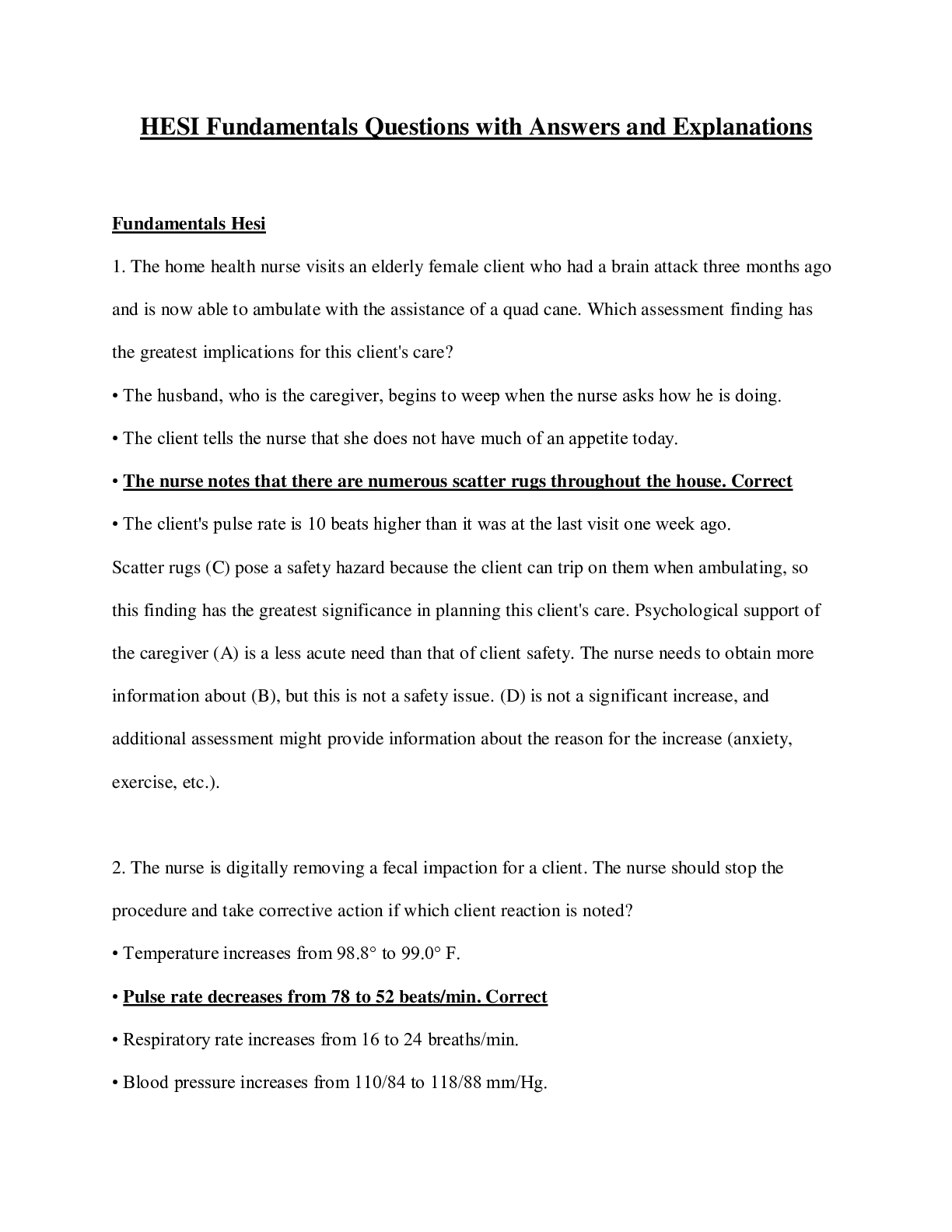





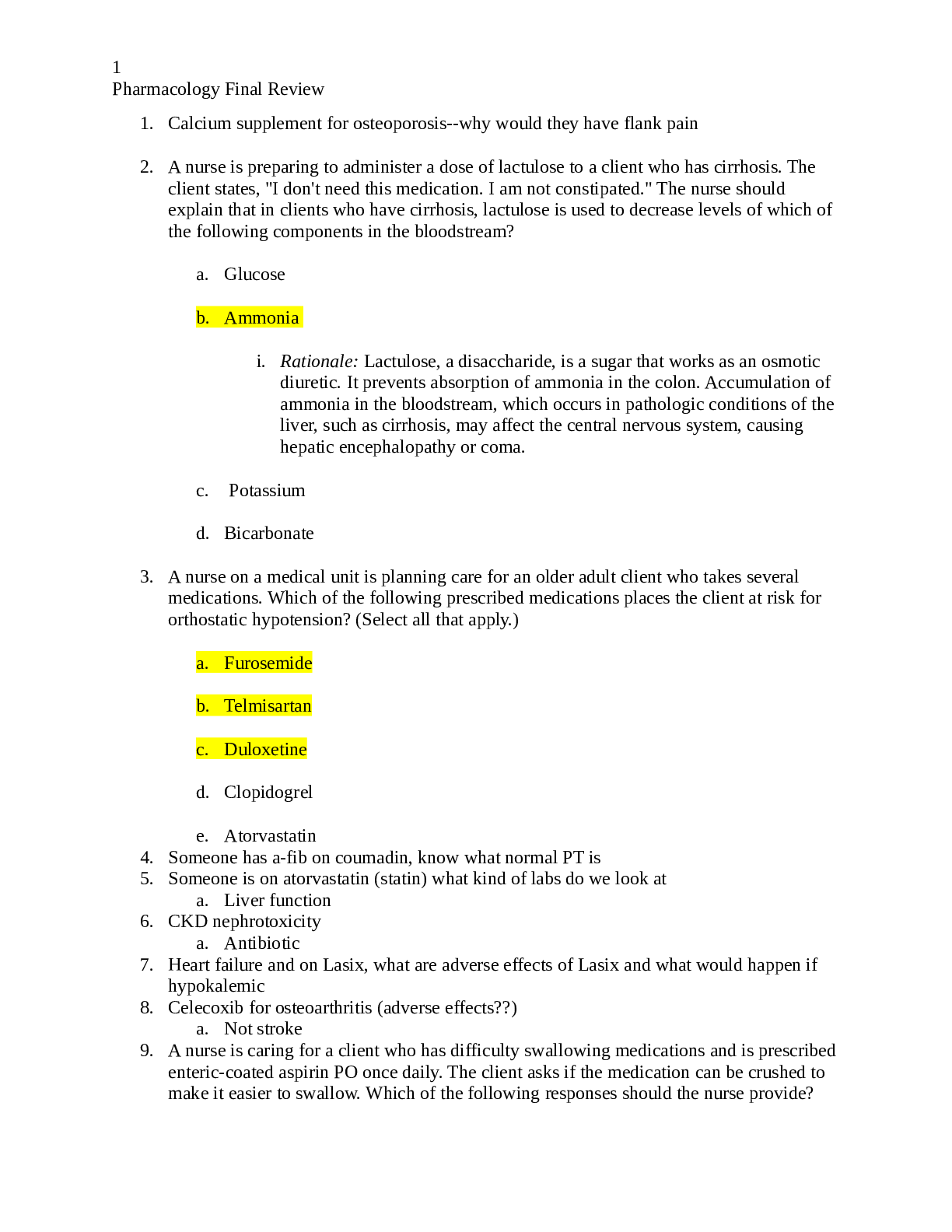
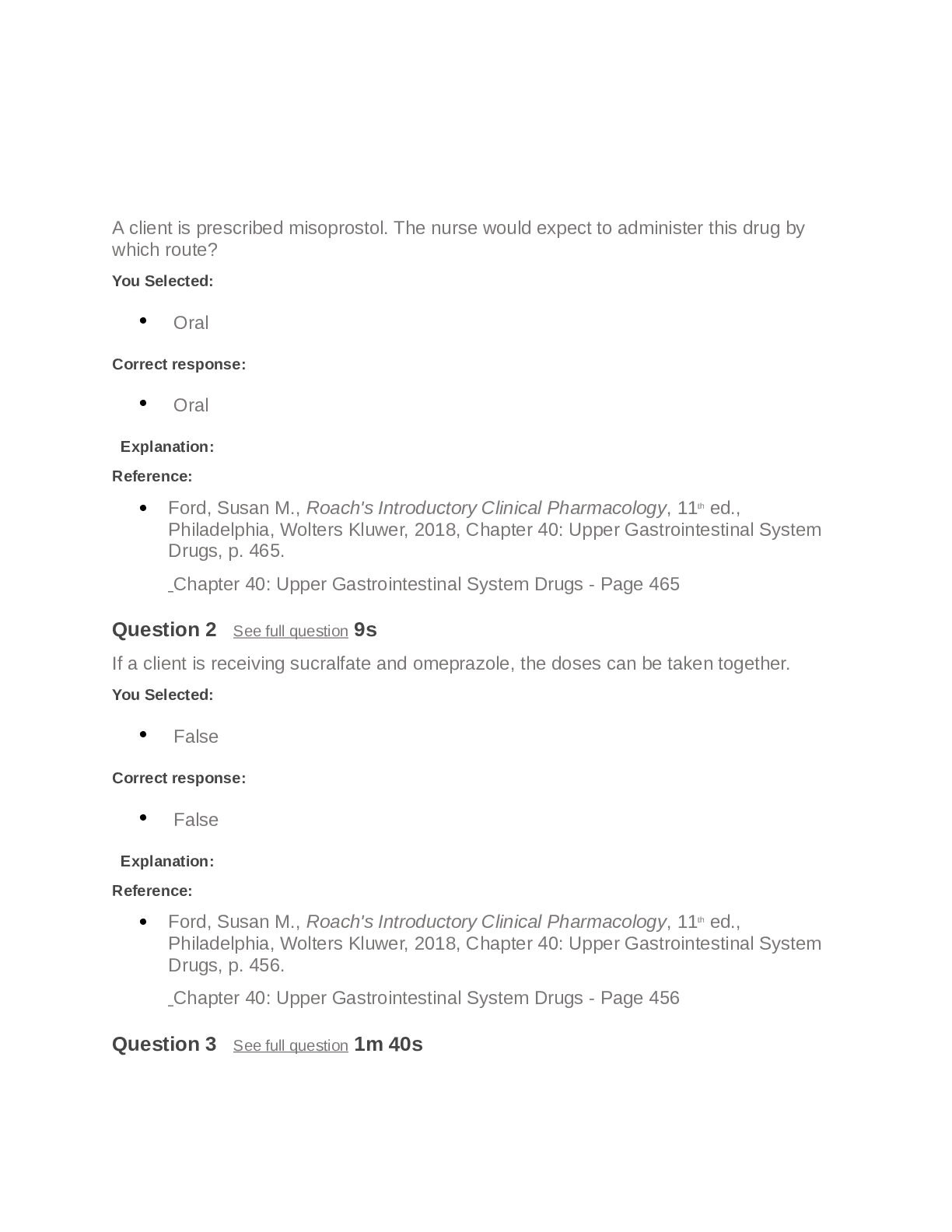

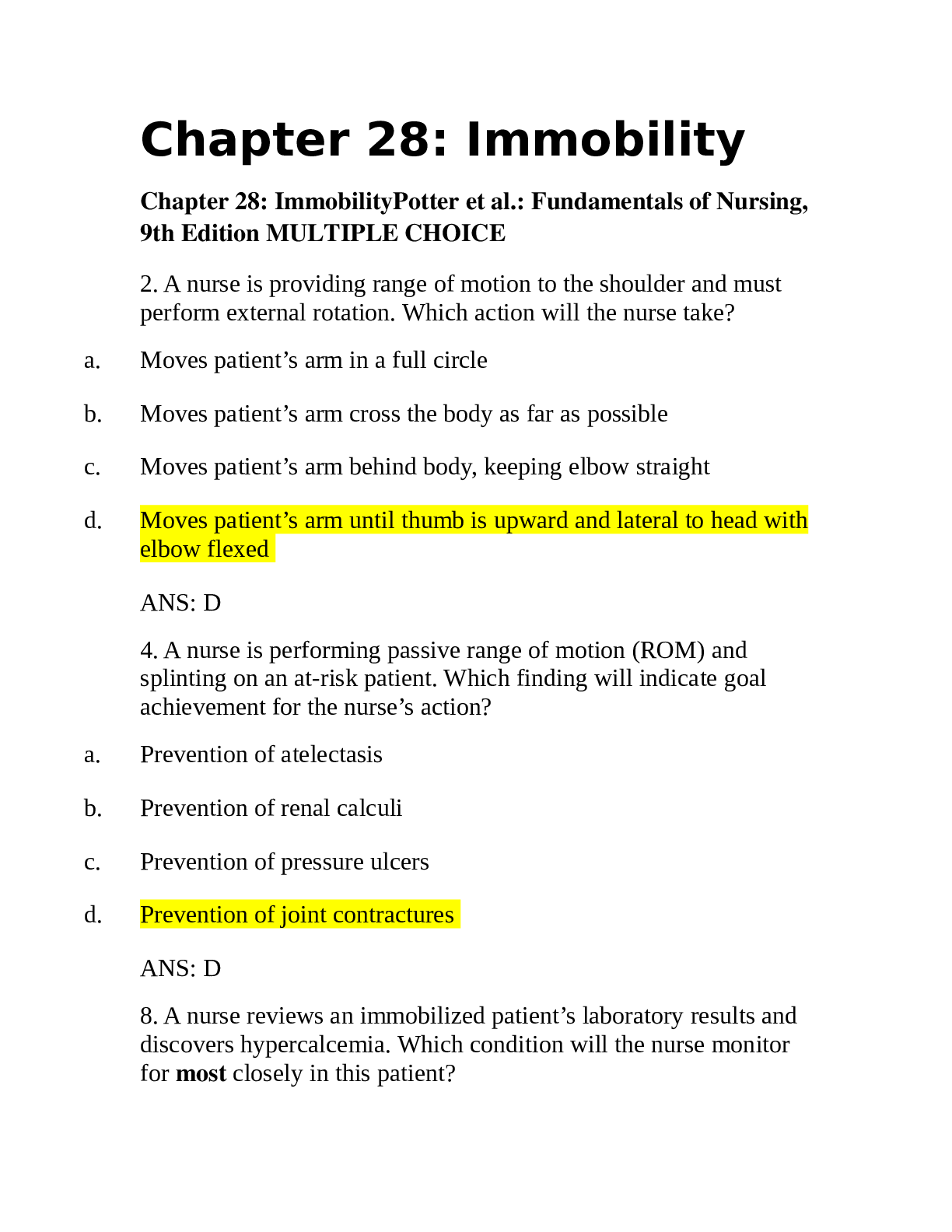
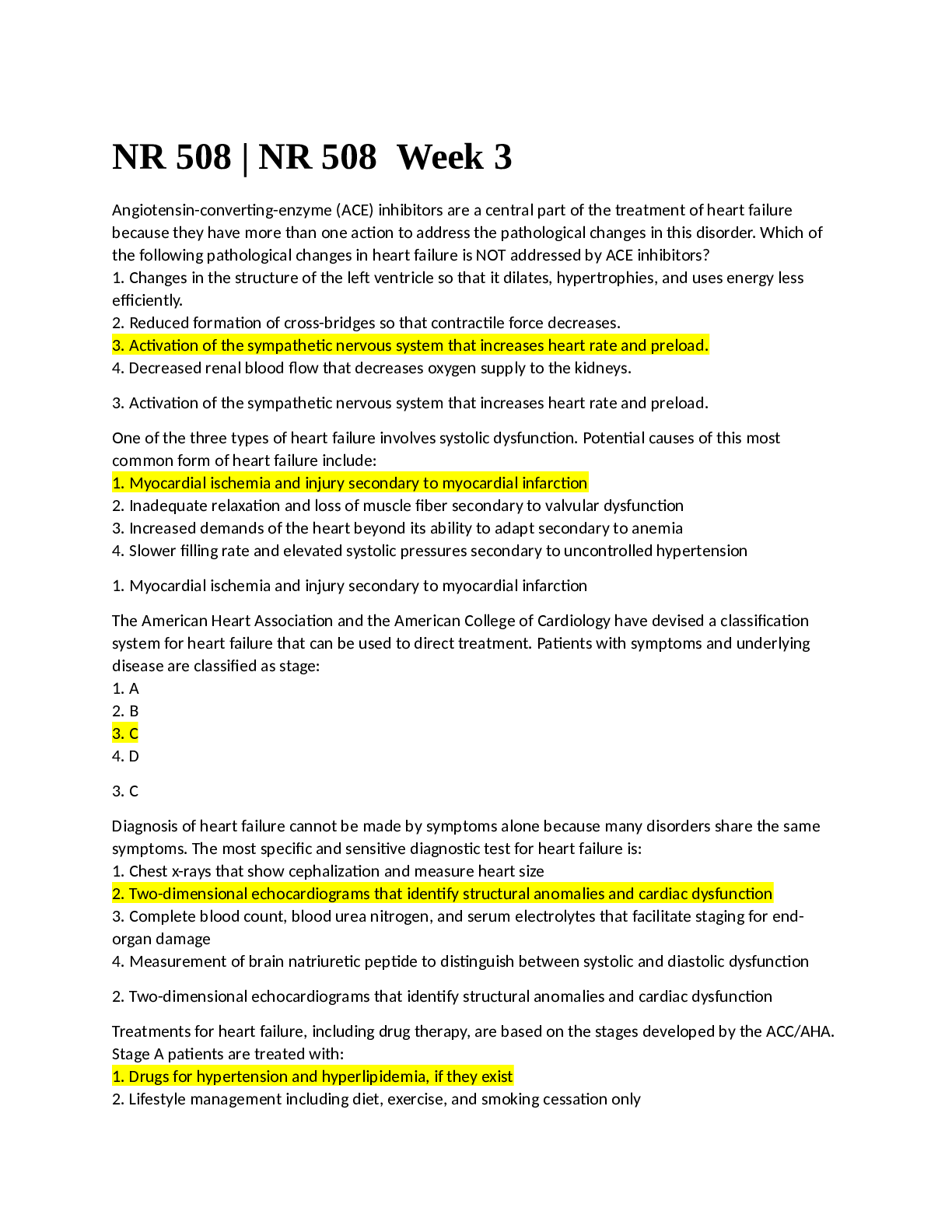

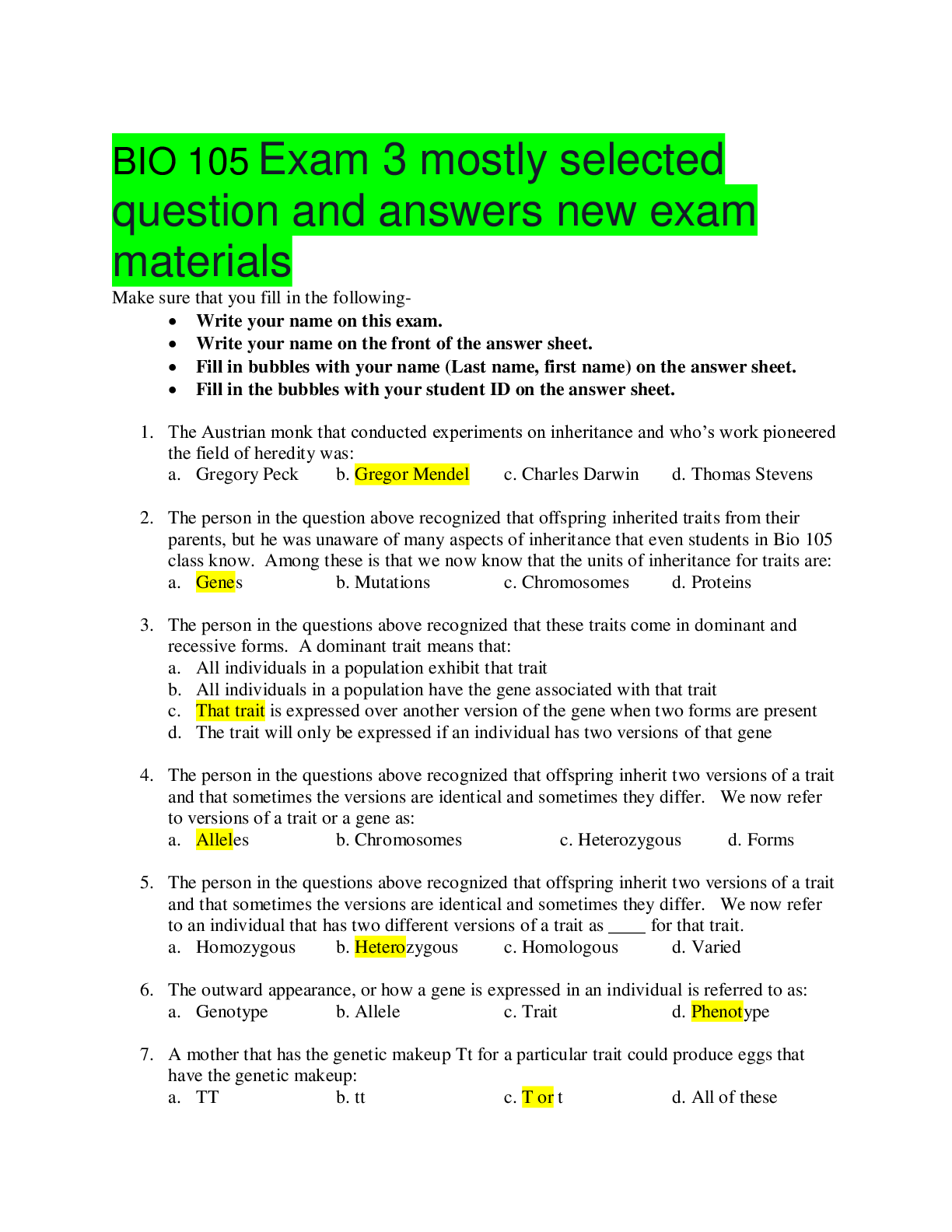

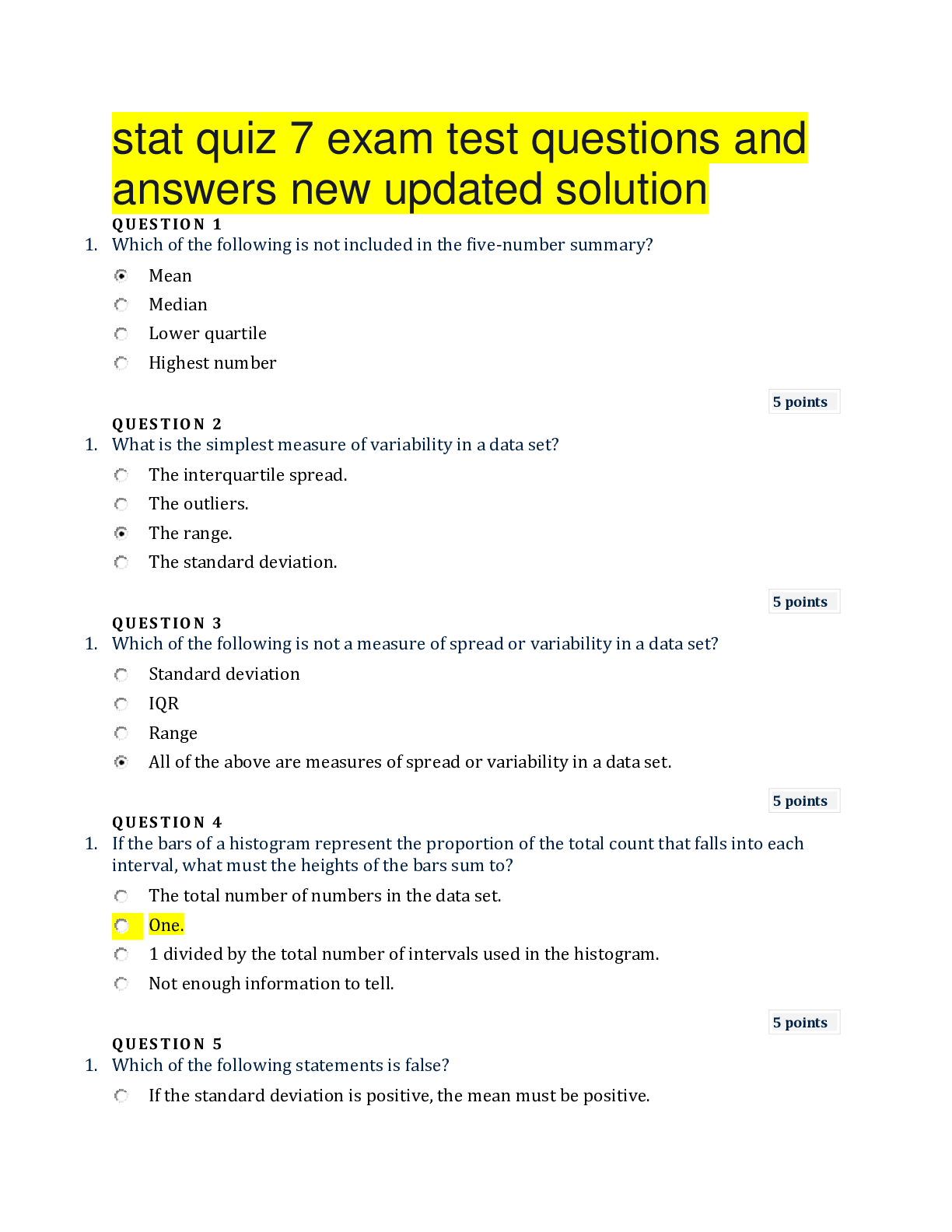



.png)
